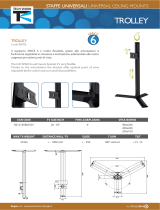8-en
OPERATION OF YOUR OPENER
Your opener can be activated by any of the following devices:
• The Lighted Door Control Button. Hold the button down until door
starts to move.
• The Outside Keylock or Keyless Entry System (if you have
installed either of these accessories).
• The Remote Control Transmitter. Hold the push button down until
the door starts to move.
Opening the Door Manually:
Door should be fully closed if possible. Weak or broken springs
could allow an open door to fall rapidly. Property damage or
serious personal injury could result.
The door can be opened manually by pulling the release handle down
and back (toward the opener). To reconnect the door, pull the release
handle straight down.
Do not use the manual release handle to pull the door opener
or closed.
When the Opener is Activated by Remote Control or Lighted Door
Control Button:
1. If open, the door will close. If closed, the door will open.
2. If closing, the door will stop.
3. If opening, the door will stop (allowing space for entry and exit of
pets and for fresh air).
4. If the door has been stopped in a partially open or closed position, it
will reverse direction.
5. If an obstruction is encountered while closing, the door will reverse.
6. If an obstruction is encountered while opening, the door will reverse
and stop.
7. The optional Protector System™ uses an invisible beam which,
when broken by an obstruction, causes a closing door to open
and prevents an open door from closing. It is STRONGLY
RECOMMENDED for homeowners with young children.
Allow a 15 minute cooling period after 5 continuous operations
of the opener.
The opener light will turn on: 1. when opener is initially plugged in;
2. when the power is briefly interrupted; 3. when the opener is
activated.
The light turns off automatically after 2-1/2 minutes. Bulb size is
24V/21W maximum.
Input Voltage...................230-240 VAC, 50Hz
Max. Pull Force ..............700N (ML700, ML750)
........................................800N (ML850)
Power .............................115W (ML700, ML750)
........................................125W (ML850)
Standby Power ...............5.5W (ML700, ML750)
........................................5.5W (ML850)
Normal Torque................7Nm (ML700, ML750)
........................................8Nm (ML850)
Motor
Type................................DC gearmotor permanent lubrication
Drive Mechanism
Drive ...............................Chain/belt with two-piece trolley on
steel rail.
Length of Travel..............Adjustable to 2.3m (7-1/2 feet)
Travel Rate .....................127-178mm (5"-7") per second
Lamp...............................On when door starts, off 2-1/2 minutes
after stop.
Door Linkage ..................Adjustable door arm. Pull cord trolley release.
Safety
Personal .........................Push button and automatic stop in down
direction. Push button and automatic stop in
up direction.
Electronic........................Automatic force adjustment
Electrical .........................Transformer overload protector and low
voltage push button wiring.
Limit Device....................Optical RPM/Passpoint detector.
Limit Adjustment .............Electronic, Semi and Fully Automatic.
Start Circuit.....................Low voltage push button circuit.
Dimensions
Length (Overall)..............3.2m (122-1/2")
Headroom Required .......30mm
Hanging Weight..............14.5 kg (32 lb)
Receiver
Memory Registers ..........12
Operating Frequency......433.92MHz
SPECIAL NOTE: Chamberlain strongly recommends that the protector
system be installed on all garage door openers.
SPECIFICATIONS
© 2008, Chamberlain GmbH
114A2802G-en All rights reserved
GARAGE DOOR OPENER WARRANTY
Chamberlain GmbH warrants to the first retail purchaser of this product that the product shall
be free from any defect in materials and/or workmanship for a period of 24 full months (2
years) from the date of purchase. The motor is warrantied to be free from defects in materials
and/or workmanship for a period of: ML850, 60 full months (5 years); ML750, 48 full months
(4 years); ML700, 36 full months (3 years) from the date of purchase. Upon receipt of the
product, the first retail purchaser is under obligation to check the product for any visible
defects.
Conditions: The warranty is strictly limited to the reparation or replacement of the parts of
this product which are found to be defective and does not cover the costs or risks of
transportation of the defective parts or product.
This warranty does not cover non-defect damage caused by unreasonable use (including use
not in complete accordance with Chamberlain’s instructions for installation, operation and
care; failure to provide necessary maintenance and adjustment; or any adaptations of or
alterations to the products), labor charges for dismantling or reinstalling of a repaired or
replaced unit or replacement batteries.
A product under warranty which is determined to be defective in materials and/or
workmanship will be repaired or replaced (at Chamberlain's option) at no cost to the owner for
the repair and/or replacement parts and/or product. Defective parts will be repaired or
replaced with new or factory rebuilt parts at Chamberlain's option.
If, during the warranty period, the product appears as though it may be defective, contact your
original place of purchase.
This warranty does not affect the purchaser’s statutory rights under applicable national
legislation in force nor the purchaser’s rights against the retailer arising from their
sales/purchase contract. In the absence of applicable national or EU legislation, this warranty
will be the purchaser’s sole and exclusive remedy, and neither Chamberlain nor its affiliates or
distributors shall be liable for any incidental or consequential damages for any express or
implied warranty relating to this product.
No representative or person is authorized to assume for Chamberlain any other liability in
connection with the sale of this product.
GB
Declaration of Conformity
The undersigned, hereby declare that the equipment specified, and all accessories,
conforms to the Directives and Standards stated.
Model:....................................................................................ML700, ML750, ML850
2004/108/EC
2006/95/EC
1999/5/EC
EN55014-1 (2000), EN55014-2 (1997), EN61000-3-2 (2000), EN61000-3-3 (1995),
EN 301 489-3 (V1.3.1), EN 300 220-3 (V1.1.1), EN60335-1 (1994), and EN60335-2-
95 (2004)
Declaration of Incorporation
A power door operator, in combination with a Garage Door must be installed and
maintained according to all the Manufacturer’s instructions, to meet the provisions of
EN12453, EN13241-1 and Machinery Directive, 89/392/EEC.
B. P. Kelkhoff
Manager, Regulatory Affairs
THE CHAMBERLAIN GROUP, INC.
845 Larch Ave.
Elmhurst, IL 60126
USA
April, 2008















